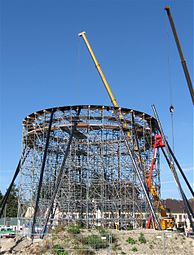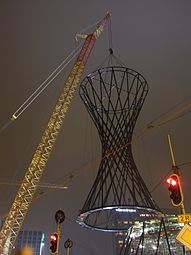
The Munich U-Bahn is an electric rail rapid transit network in Munich, Germany. The system began operation in 1971, and is operated by the municipally owned Münchner Verkehrsgesellschaft. The network is integrated into the Münchner Verkehrs- und Tarifverbund and interconnected with the Munich S-Bahn. The U-Bahn currently comprises eight lines, serving 96 stations, and encompassing 103.1 kilometres (64.1 mi) of routes.
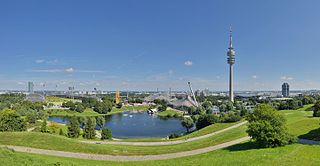
The Olympiapark in Munich, Germany, is an Olympic Park which was constructed for the 1972 Summer Olympics. Located in the Oberwiesenfeld neighborhood of Munich, the Park continues to serve as a venue for cultural, social, and religious events, such as events of worship. It includes a contemporary carillon. The Park is administered by Olympiapark München GmbH, a holding company fully owned by the state capital of Munich. The Olympic Park Munich was also considered to be an architectural marvel during the 1972 Olympics in Munich, Germany.

Sendling is a borough of Munich. It is located south-west of the city centre and spans the city boroughs Sendling and Sendling-Westpark. Sendling is subdivided into Obersendling, Mittersendling and Untersendling. Untersendling and Mittersendling are located in the borough of Sendling, and Obersendling is located in the borough of Thalkirchen-Obersendling-Forstenried-Fürstenried-Solln.

Bogenhausen is the 13th borough of Munich, Germany. It is the geographically largest borough of Munich and comprises the city's north-eastern quarter, reaching from the Isar on the eastern side of the Englischer Garten to the city limits, bordering on Unterföhring to the north, Aschheim to the east and the Haidhausen borough to the south.
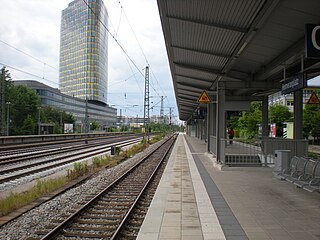
Munich Heimeranplatz is a railway and Munich U-Bahn interchange station. It sits on the border of two Munich boroughs, Laim and Schwanthalerhöhe. It offers transfer between S-Bahn and U-Bahn as well as local bus services and serves as a transportation hub for the Westend and eastern Laim.

The Munich tramway is the tramway network for the city of Munich in Germany. Today it is operated by the municipally owned Münchner Verkehrsgesellschaft and is known officially and colloquially as the Tram. Previous operators have included Société Anonyme des Tramways de Munich, the Münchner Trambahn-Aktiengesellschaft, the Städtische Straßenbahnen and the Straßenbahn München.

The Dachauer Straße is the longest street in Munich with a length of 11.2 km and it received its name since it is the connecting road to Dachau Palace. In the north of Munich, it is part of the Bundesstraße 304.
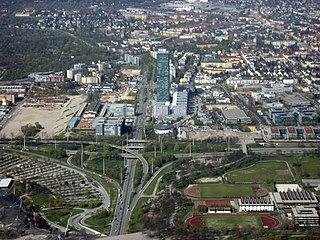
Moosach is the 10th northwestern district of Munich, Bavaria, Germany. It is sectioned in the urban districts Hartmannshofen, Pressestadt and Borstei.

Rita McBride is an American artist and sculptor. She is based in Los Angeles and Düsseldorf. Alongside her artistic practice, McBride is a professor at the Kunstakademie Düsseldorf, and served as its director until 2017. McBride is married to Glen Rubsamen, an American painter from Los Angeles.

The Donnersbergerstraße is a street in the Munich district Neuhausen, in the city district of Neuhausen-Nymphenburg. It connects the Rotkreuzplatz with the Arnulfstraße in the north-south direction. It is named after the Privy Councilor and Supreme Chancellor of the Bavarian elector Maximilian I, Joachim Freiherr von Donnersberg (1561–1650), who came from the Munich patrician family, Donnersberger.

The Arnulfstraße is a 3.8 km long urban street in Munich. It leads from the Bahnhofplatz in the Ludwigsvorstadt through the Maxvorstadt west to Romanplatz in Neuhausen. Over the Hackerbrücke, there is a connection to the Landsberger Straße, which runs parallel to the south of the railway tracks. Until 1983, the tram line 3 drove through the Arnulfstraße. It was initially diverted in the course of the Munich S-Bahn construction and then shut down. In 1996, the tram service was reopened on the Arnulfstraße with the line number 17.
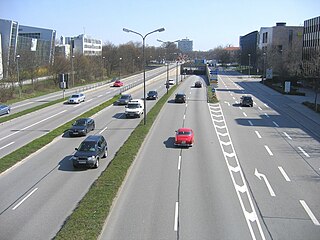
The Schenkendorfstraße is a four- to ten-lane section of the Mittlerer Ring in Munich.

The Landsberger Straße is one of the main arterial roads in Munich.

The Trappentreustraße is a street in the west of Munich and part of the Mittlerer Ring.

The Isarring is a four-lane section of the Mittlerer Ring, the Bundesstraße 2 R, in Munich. It is used by 110,000 cars every day and was constructed in 1966.

Englschalking is a district of the Bavarian capital Munich and belongs to the district 13 Bogenhausen.
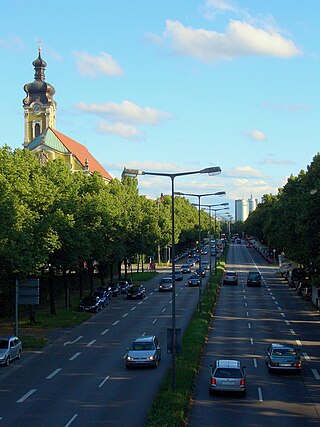
The Landshuter Allee is an avenue in Munich and through most of its course it is part of the Mittlerer Ring, the Bundesstraße 2 R. It joins Donnersbergerbrücke at Arnulfstraße in the Neuhausen district and runs from Dachauer Straße west of the Olympiapark to Moosacher Straße west of the Olympic village in the Moosach district. The B 2R leaves the intersection-free avenue at the Landshuter Allee and continues on the Georg-Brauchle-Ring. The Landshuter Allee now functions as the B 304 and connects the Mittlerer Ring with the northern tangent of the Outer Ring, which is only partially complete. The large width of the Landshuter Allee of 54 metres between the houses is striking. It crosses the Nymphenburg-Biedersteiner Kanal.
Bonner Platz, 1906 named after the city of Bonn, is a square in the Schwabing district of Munich, in the Schwabing-West quarter. The underground station of the same name Bonner Platz of the line U3 is located here.

The Petuelring is an approximately 2.2 km long road in the north of Munich and part of the Mittlerer Ring. It runs between Georg-Brauchle-Ring and Schenkendorfstraße.

Kurfürstenplatz is a square in the Munich district of Schwabing and is located about two and a half kilometres north of the city centre. It is the intersection of several streets and tram lines and was built in 1915 and named after the Elector Maximilian II. Emanuel, born in Munich in 1662.


